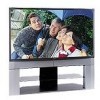Toshiba 72HM196 Operating Guide - Page 9
TV back panel connections
 |
UPC - 022265251485
View all Toshiba 72HM196 manuals
Add to My Manuals
Save this manual to your list of manuals |
Page 9 highlights
HM196_EN.book Page 9 Tuesday, May 30, 2006 2:18 PM Chapter 1: Introduction TV back panel connections For an explanation of cable types and connections, see the Installation Guide. 1 2 34 5 6 1 VIDEO 1 IN - Composite video and analog audio inputs plus optional S-video inputs for connecting devices with composite video or S-video output. Note: Composite video and S-video cables carry only video information; separate audio cables are required for a complete connection. 2 ColorStream® HD-1 IN and ColorStream® HD-2 IN - Two sets of ColorStream® high-definition component video inputs (with analog stereo audio inputs) for connecting devices with component video output, such as a Toshiba DVD player with ColorStream®. Note: • Component video cables carry only video information; separate audio cables are required for a complete connection. • HDMI 1 (and 2) share analog audio inputs with ColorStream HD-1 (and HD-2). To specify the use of the audio inputs for a connected ColorStream (component video) device, see "Setting the ColorStream HD audio mode" on page 28. 3 Variable Audio OUT - Standard analog audio outputs for connecting an analog amplifier with external speakers. 4 A/V OUT - Standard composite video and analog audio outputs for connecting a VCR for editing and dubbing. Note: The A/V OUT terminals will output AUDIO ONLY (no video) in the following instances: • When the TV's INPUT mode is HDMI, or ColorStream (- "Selecting the video input source to view," page 32). • When the POP window is open (- page 40). • When the MP3 Audio Player is active (- page 66). 5 IR OUT - For controlling infrared remote-controlled devices through the TV. You can connect up to two devices with an IR blaster cable, and then control the devices using the TV's IR pass-through features. 6 ANT 1 and ANT 2 - Two inputs that support analog (NTSC) and digital (ATSC) off-air antenna signals and analog and digital Cable TV (QAM) signals. Note: If you have an antenna only, connect it to ANT 1. If you have both cable TV and an antenna, connect the cable TV to ANT 1 and the antenna to ANT 2. 9 HM196 (E/F) Web 213:276















